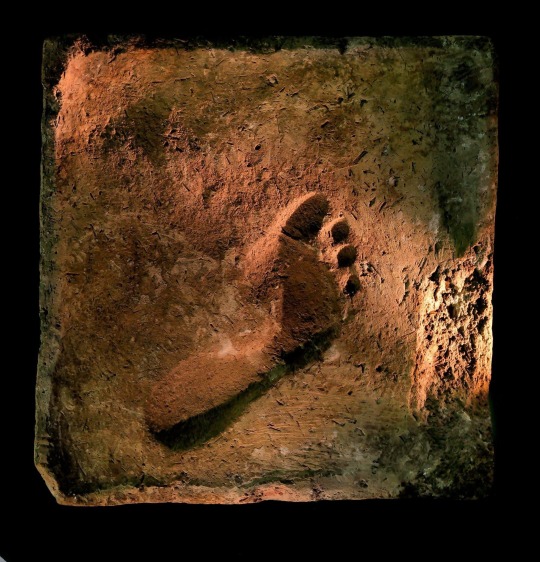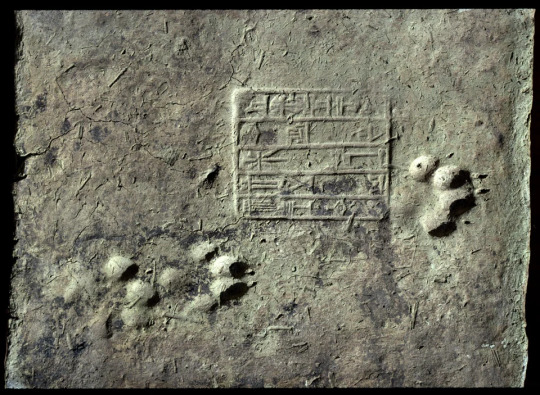Posts about ancient Mesopotamian mythology and culture
Don't wanna be here? Send us removal request.
Text

A footprint left in a piece of wet mud brick in Ur 4,000 years ago. Ancient Mesopotamia
https://bit.ly/32p1ADr
5K notes
·
View notes
Photo

Alabaster heads from statues with shell and lapis lazuli inlay Khafaje, Iraq, Nintu Temple level VI ca. 2475-2300 BCE
Penn Museum, 38-10-51 and 38-10-52
95 notes
·
View notes
Video
youtube
GILGAMESH LAMENT FOR ENKIDU
From Standard Babylonian Epic of Gilgamesh
Tablet VIII, lines 42 - 49; 52-56; 59
--
We all lament for Enkidu, great friend of Gilgamesh
89 notes
·
View notes
Text
Abdulameer al-Hamdani | Iraq's Heritage: An Update
youtube
Update on archaeological and heritage situation in Iraq presented by Iraqi Minister of Culture.
8 notes
·
View notes
Photo

Western Asiatic Stone Eye Idol, Ca.4000 BC.
Attractive brown stone Tell Brak Eye Idol consisting of a square body with slight shoulders, a short neck and two incised eyes.
Size: L: 120mm / W: 100mm
Courtesy: Pax Romana
165 notes
·
View notes
Photo

Seal of King Ur-Nammu; Cylinder seal (c. 2100 BCE) depicting goddesses conducting mortal males through a religious rite, Sumerian
97 notes
·
View notes
Photo

This is my rendition of a letter from the Neo-Assyrian period of one Aššur-reṣiwa to his superior, memorably asking who he doesn’t respond to his messages–“why is my master silent while I shake and roam around like a dog?” https://www.instagram.com/p/CHYX3DwrosO/?igshid=1alh90qrtmt9
71 notes
·
View notes
Text



Gudea of Lagash
Paragonite
Mesopotamia (Iraq), city-state of Lagash
Neo-Sumerian period, Lagash II dynasty 2150-2125 BCE
Detroit Institute of Arts, 82.64
874 notes
·
View notes
Photo

Cosmetic box with handle Ivory Excavated at Ur (Tell al-Muqayyar) Neo-Assyrian/Late Babylonian period, ca. 700-600 BCE
British Museum, 116544
134 notes
·
View notes
Text

Statue of Gudea of Lagash
Diorite
Mesopotamia (Iraq), probably Tello/Girsu, ca. 2125 BCE
Cleveland Museum of Art, Cleveland, OH
43 notes
·
View notes
Photo

Priestess/Queen Puabi’s gold earrings
2600 B.C.E.
Royal Cemetery of Ur
Mesopotamia
(via Pinterest)
62 notes
·
View notes
Photo

Sumerian Temple Hymn, baked clay, circa between 1800 and 1600 BCE (Old Babylonian), currently located at the Walters Art Museum.
This tablet, inscribed on all four sides, is one of the best preserved copies of the Sumerian hymn to the temple at Kesh.
The popular hymn, written in praise of the temple built for the mother-goddess Nintu in the city of Kesh in southern Mesopotamia, describes the temple in both physical and heavenly terms.
2K notes
·
View notes
Photo

Bilingual Sumerian-Akkadian Hymn to Ishtar
This tablet from the Library of Ashurbanipal at Nineveh is a hymn to Ishtar, goddess of love, fertility, and war. While the prayer is originally in Sumerian, every other line gives an Akkadian translation (visible in the placement of line dividers after every group of two lines), which suggests that even in antiquity, Sumerian may have begun to be difficult to understand. It is likely that Sumerian was no longer spoken after about 2000 BCE, but it was preserved in sacred and scholarly texts in Mesopotamia for the next two millennia, analogously to the way Latin is preserved in certain genres and scholarly contexts alongside modern languages today. (Source)
Nineveh, Neo-Assyrian, c. 911-612 BCE.
British Museum.
613 notes
·
View notes
Photo


Two winged apkallu figures from Room T of the Northwest Palace, Nimrud Gypsum alabaster (”Mosul marble”) Neo-Assyrian period, reign of Ashurnasirpal II (883-859 BCE)
The Metropolitan Museum of Art, New York
377 notes
·
View notes
Photo

Inscribed brick in Akkadian from Ešnunna, Iraq which a dog once walked over, leaving behind their paw prints. Circa 2000-1900 BCE.
3K notes
·
View notes
Text
Not a standard content for this blog,but... I simply had to.
Thanks so much @enkidusbi for providing me with lots of historicaly accurate laughs.








hmmm how could i best articulate my love for this ancient literary work...
shitposting it is
3K notes
·
View notes
Photo





Eye Inlay (doubled) - Sumerian or Elamite - lapis lazuli, marble - c.2nd half of the 3rd Millennium BCE
Eye inlay - lapis lazuli, limestone and black stone - Syrian, Early Dynastic Mesopotamian - c.2550-2250 BCE
Child’s left eye inlay - glass - Late Period, Egypt - c.664-332 BCE
A pair of child’s eye inlays - glass - Late Period, Egypt - c.664-332 BCE
A pair of eye inlays - glass - Late Period, Egypt - c.664-332 BCE
3K notes
·
View notes